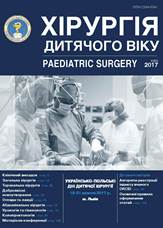Efficacy improvement of surgical care in patients with hirschsprung’s disease considering modern diagnostic potential
DOI:
https://doi.org/10.15574/PS.2017.57.97Keywords:
Hirschsprung’s disease, diagnostics, treatmentAbstract
Objective – to study diagnostic utility of instrumental, morphological and histochemical methods of research in congenital anomalies of colon in children and their role in determination of surgical tactics.Material and methods. 847 patients with constipations and other gastrointestinal dysfunction were followed up during the period 2007 – 2016. Out of them 119 (14.05%) children had congenital anomalies, including Hirschsprung’s disease (HD) in 36.13% cases. Clinical, instrumental, morphological and histochemical indexes have been determined for monitoring efficacy of diagnostics and treatment of children with HD before and after treatment.
Results. There were founded 36.13% patients with HD, 45.38% – with other dysganglionosis of gut (intestinal dysplasia A and B, hypoganglionosis, immature of ganglionar cells), 2.52% cases of mucoviscidosis and 15.97% children with other congenital pathologies. It was established that histological and histochemical researches of biopsic specimen of lesion increase accuracy of diagnostics of congenital anomalies of gut in children. Irrigography and intraoperational visual assessment of affected gut segment are not accurate diagnostic measures and often provoke mistakes in determination of resection boundary.
Conclusions. 1. Preliminary diagnosis of congenital anomalies of gut establishes using contrast irrigography, which is not always reliable, particularly in newborns and infants. 2. Histological staining of biopsic specimen of affected gut is a main diagnostic method for HD. 3. The efficacy of surgical treatment in children with HD increases due to timely verification of diagnosis based upon morphological and histochemical examinations. Transition zone must be verified by pathomorphologes as well. 4. The complex use of X-ray, morphological and histochemical methods of research allow timely establishing of HD diagnosis in children nearly in 100% cases and using adequate surgical tactics, including determination of resection zone.
Downloads
Issue
Section
License
The policy of the Journal “PAEDIATRIC SURGERY. UKRAINE” is compatible with the vast majority of funders' of open access and self-archiving policies. The journal provides immediate open access route being convinced that everyone – not only scientists - can benefit from research results, and publishes articles exclusively under open access distribution, with a Creative Commons Attribution-Noncommercial 4.0 international license(СС BY-NC).
Authors transfer the copyright to the Journal “PAEDIATRIC SURGERY.UKRAINE” when the manuscript is accepted for publication. Authors declare that this manuscript has not been published nor is under simultaneous consideration for publication elsewhere. After publication, the articles become freely available on-line to the public.
Readers have the right to use, distribute, and reproduce articles in any medium, provided the articles and the journal are properly cited.
The use of published materials for commercial purposes is strongly prohibited.

